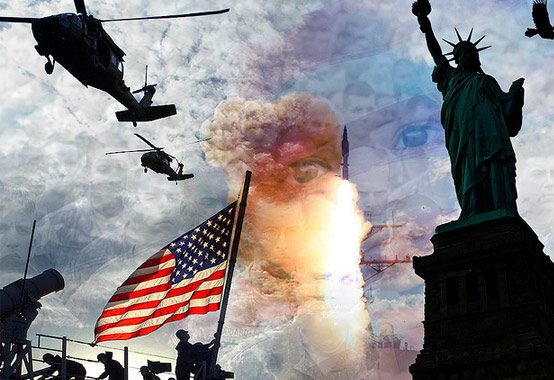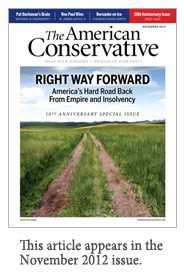The Sun Sets on American Empire

Throughout the campaign season, Mitt Romney and Barack Obama alike insisted that the 21st century must be another American century—that the U.S. should continue to be the world’s predominant military, economic, and political power for generations to come. After ten years of shattered hegemonic dreams, leaders of both parties still feel compelled to declare their loyalty to the vision that inspired the follies of the Bush era. Foreign-policy debate continues to turn on the question of how to preserve American hegemony, rather than how to secure U.S. interests once America is no longer so dominant. What nobody in Washington can acknowledge is the subject that this book addresses: the American Century, to the extent that it ever was real, is now definitely at an end.
Henry Luce famously coined the phrase in a 1941 issue of Life. He declared that America’s role was to “exert upon the world the full impact of our influence for such purposes as we see fit by such means as we see fit.” As Luce imagined it, that influence would extend to economic and cultural dominance as well as political. His missionary vision took for granted that America had not only the right but the obligation to propagate its values and exercise leadership throughout the world. Seventy years later, Luce’s idea is still part of Washington’s bipartisan consensus, but in recent years it has collided with the practical limits of American power.
As editor Andrew Bacevich explains in his introductory remarks, the purpose of the essays assembled in this volume is not “to decry or to mourn the passing of the Short American Century (much less to promote it resurrection) but to assess its significance.” Each chapter is a study of different aspects of this era of American preeminence, reflecting on matters of race, consumerism, and globalization, as well as reviewing the history of the last 70 years with special attention to the critics of U.S. policies abroad. Though often sharply critical of the moral and political failings of this epoch, the contributors—a distinguished collection of historians and international-relations scholars—are also judicious in their interpretations. The book aspires to be much more than a series of polemics, and it is very successful.
If the American Century is at an end and the contributors are performing a postmortem, what do they identify as the patient’s cause of death? One answer is that American economic and political strength have been abused and run down through mismanagement. As Emily Rosenberg discusses in her chapter on consumerism, America’s culture of mass consumption cultivated habits that have sapped American wealth and power through the accumulation of enormous private and public debt, while the spread of the consumerist ethos around the world has further eroded America’s earlier economic advantages.
American economic and political strength are also victims of the American Century’s own successes. As Jeffry Frieden explains in his chapter on globalization, the success of the United States in leading the rebuilding of the global economy in the wake of World War II produced a competitive economic order that has hastened the end of American preeminence. Viewed this way, the American Century ended because it is no longer needed. Likewise, Akira Iriye argues that the world has become so integrated economically and culturally that the global order that is replacing the U.S.-led one will not be dominated by any one nation.
Proponents of continued U.S. hegemony sometimes attempt to scare Americans with visions of a world led by Russia or China, but what comes after the American Century will be nothing like that. According to Iriye, “it will not be a Chinese century or an Indian century or a Brazilian century. It will be a long transnational century.” This is a useful reminder that it is extremely unusual for any one nation to be hegemon over the globe, and it is not something that will be quickly or easily repeated.
While this book is a “dissenter’s guide” to the period of “putative American dominion,” the contributors’ judgments of the American Century are not always negative. At least one, David Kennedy, sees its early conclusion as the result of a disastrous departure from the postwar American legacy abroad during the Bush administration. Kennedy is offended that the Bush administration “trashed” the achievements of presidents Wilson, Roosevelt, and Truman and weakened some of the major international institutions created after World War II. Instead of seeing the Bush era as the logical conclusion of decades of American triumphalism, Kennedy views it as a betrayal of the creators of the American Century.
At the other end of the spectrum, Walter LaFeber dismisses the idea of an American Century as a fantasy, a “dream” that Luce “conjured up in order to persuade” Americans to go to war. As LaFeber sees it, the pretensions to an American Century were exploded by the postwar division of Europe and the Cold War and have been mocked once again by the recent failures of the “freedom agenda.” Yet he concludes on the grim note that this fantasy will continue to distort U.S. foreign policy for the foreseeable future, as long as Americans ignore its consequences.
Pragmatic realists have been among the strongest critics of America’s abuses of its power abroad. T.J. Jackson Lears recounts the evolving views of George Kennan, Walter Lippmann, Reinhold Niebuhr, and Sen. William Fulbright in his study of the pragmatic realist tradition in the 20th century. Lears traces the tradition back to its anti-imperialist roots in the thought of William James, who was among the foremost opponents of American expansion overseas at the turn of the last century, especially the annexation of the Philippines. James’s respect for pluralism informed his hostility to any political project aimed at denying the self-determination of other nations, and his pragmatism led him to prefer the instruction of experience over the abstractions used to agitate for war.
The careers of Kennan and Niebuhr best reflect the tensions in this tradition between accepting a significant American political and military role abroad and recoiling from abuses of power, ideological enthusiasm, and the militarization of foreign policy. Lears says of Niebuhr and his support for U.S. entry into World War II that the “Jamesian tradition might be anti-imperial but not necessarily anti-interventionist—if this interventionist argument was grounded in a convincing assessment of consequences.” It was in response to the consequences of abuses of the containment doctrine Kennan had defined that he became what Lears calls “a prophet of discriminating restraint,” as he showed in his criticism of the superpowers’ nuclear arms build-up and in his opposition to the Vietnam War. Although Niebuhr recognized the need for U.S. involvement in World War II, the theologian was appalled by Luce’s call for an “American Century,” which he dismissed as a new “white man’s burden.”
Politicians still use the phrase “American Century” as shorthand for U.S. global preeminence, and there continue to be demands for a new one. The neoconservative Project for a New American Century—which disbanded in 2006 only to be reorganized as the Foreign Policy Initiative in 2009—is one well-known example, but it would be wrong to see a fixation on another American Century as something confined to that faction of the Republican Party. The dream of perpetual power is based on much more widely shared assumptions that America is not subject to the same limitations that have constrained all other great powers in the past.
 Calls for another American Century are closely linked to an emphasis on a peculiar, distorted understanding of American exceptionalism. At their best, recent references to this idea have been expressions of respect for America’s tradition of constitutional government, but more typically they have been little more than appeals to what was once called “national greatness conservatism,” which defines America’s worth in terms of its commitment to global hegemony and military supremacy. Just as often, these references have been clumsy appeals to a form of American nationalism in which the country is conceived of as an ideological project. When proponents of continued U.S. hegemony invoke American exceptionalism, it is usually an idea of America as a crusading power regularly interfering in the affairs of other nations that they have in mind.
Calls for another American Century are closely linked to an emphasis on a peculiar, distorted understanding of American exceptionalism. At their best, recent references to this idea have been expressions of respect for America’s tradition of constitutional government, but more typically they have been little more than appeals to what was once called “national greatness conservatism,” which defines America’s worth in terms of its commitment to global hegemony and military supremacy. Just as often, these references have been clumsy appeals to a form of American nationalism in which the country is conceived of as an ideological project. When proponents of continued U.S. hegemony invoke American exceptionalism, it is usually an idea of America as a crusading power regularly interfering in the affairs of other nations that they have in mind.
Rejecting the ambitions of the American Century is to some extent “to concede that American Exceptionalism is an illusion or an outright fraud,” as Bacevich says in the concluding chapter. As long as most Americans imagine that there is a necessary link between our country’s unique and admirable qualities and an activist, hegemonic role around the world, the fantasy will persist that the American Century has never ended and can continue indefinitely. The last 70 years have been a transformative time in our history, but they do not define the whole of the American experience, nor should we mistake America’s role during this period for our country’s natural or destined role. The Short American Century serves as a timely and necessary corrective to the illusion that American global pre-eminence is unending, an empire to last, if not a thousand years, at least another hundred.
Daniel Larison is a TAC senior editor. His blog is www.theamericanconservative.com/Larison.